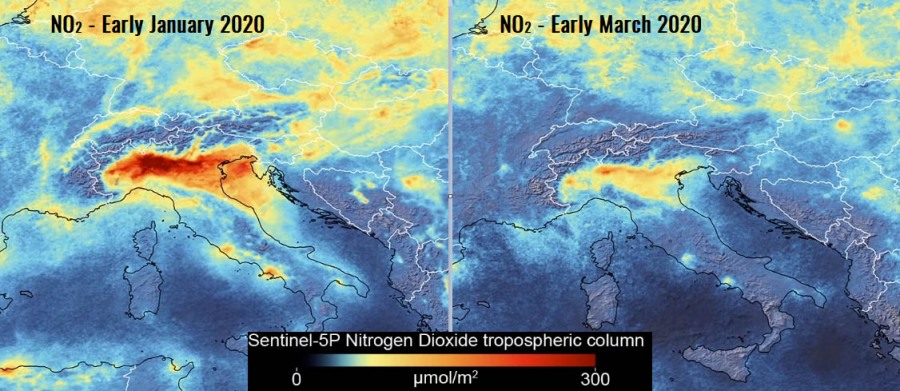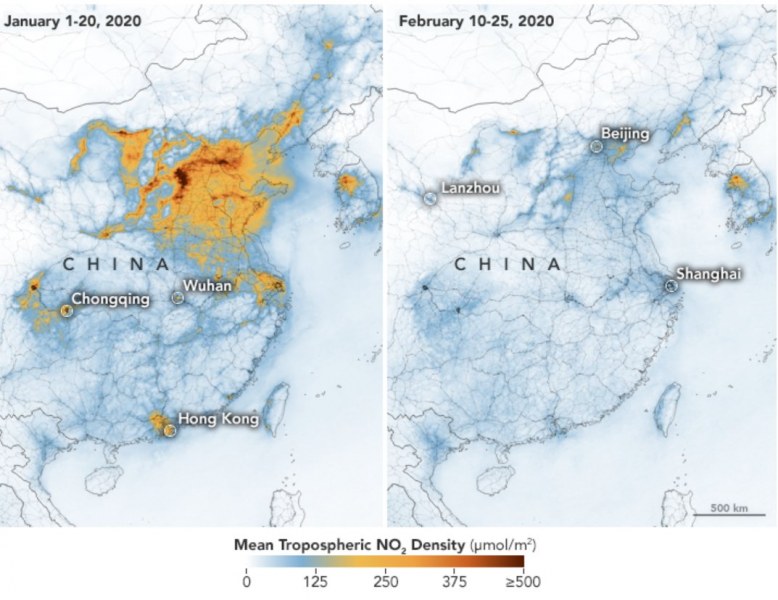The data analysis by the Copernicus Sentinel-5P satellite reveal a significant decline of the air pollution across Italy, particularly visible across northern Italy where normally the high values of nitrogen dioxide (NO2) emissions are observed. This is a factual effect of the nationwide lockdown to prevent the spread of the Coronavirus / COVID-19.
The animation shows the fluctuation of nitrogen dioxide emissions across Europe from 1 January 2020 until 11 March 2020, using a 10-day moving average.
We can see a quite significant decline in nitrogen dioxide emissions particularly over the Po Valley in northern Italy. The emissions indeed also depend on the weather pattern and cloud cover, but the change is pretty obvious across this region which was the first area to suffer the effects of the spread of the virus and therefore first to face the most robust restrictions and lockdown of transportation and industrial activity across several regions in northern Italy.
Note: The Sentinel-5 Precursor – also known as Sentinel-5P – is the first Copernicus mission dedicated to monitoring our atmosphere. The satellite carries the Tropomi instrument to map a multitude of trace gases such as nitrogen dioxide, ozone, formaldehyde, sulfur dioxide, methane, carbon monoxide, and aerosols – all of which affect the air we breathe and therefore our health, and our climate.
Another comparison map indicates the concentrations at the end of February (24th) versus early March (8th). A huge change is visible!
Nitrogen dioxide is part of a group of gaseous air pollutants produced and is generated by the combustion of fossil fuels especially from heating systems, vehicle engines, industrial combustion, and power plants. Therefore it is not surprising that we are facing a decline in its emission after the lockdown and suspension of many commercial activities across northern Italy. NO2 is known for its negative effect on the lungs and on those who have respiratory problems, aggravating them.
A similar result occurred in China during the COVID-19 outbreak there. The NO2 concentrations have had a very significant decline, remaining at the minimum levels in the last 15 years. Like Italy, China had robust restrictions there to limit the spread of the virus. The comparison map indicates the NO2 concentrations for Jan 1-20th versus Feb 10-25th, 2020.
There's been a sensational drop in pollution across #China as the nation attempts to contain COVID-19, the disease brought about by the novel #coronavirus. #PMO #coronavirusindia #CoronaVirusUpdate #ISRO #sentinel5p#AajTak pic.twitter.com/xlLXrAvCRv
— anil kumar singh (@singhanil854) March 3, 2020
Extremely low NO2 pollution concentrations observed over China and Wuhan in the past week, while measures were taken to battle the #Coronavirus. The week before shows “business as usual”. @tropomi #sentinel5p @ESA_EO @CopernicusEU pic.twitter.com/oyhlNBmMns
— Henk Eskes (@henk_eskes) February 1, 2020
See how the weather could effect the COVID-19 spread:
Arctic cold outbreak develops across the United States tonight and continues into the weekend
There is also another interesting effect of Coronavirus outbreak lately – Global CO2 levels have temporarily stopped rising, likely due to the industry slowdown during the outbreak:
Arctic cold outbreak develops across the United States tonight and continues into the weekend


